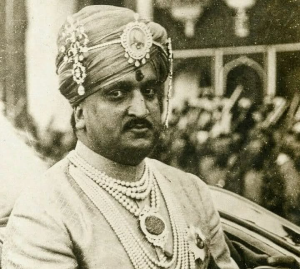Today let’s talk about Maharaja Hari Singh Biography: Maharaja Hari Singh from 1895 to 1961. He was born on September 23, 1895, in Amar Mahal Palace, Jammu, into the Dogra dynasty that had ruled the princely state of Jammu and Kashmir since 1846. He was the son of Raja Amar Singh and the nephew of Maharaja Pratap Singh, the reigning monarch at the time of his birth.
Growing up in the royal household, Hari Singh received a privileged education that combined traditional Indian learning with Western influences. He was tutored privately and later attended the Mayo College in Ajmer, an institution established specifically for the education of Indian princes and nobles. His upbringing prepared him for the complex political landscape he would later navigate as ruler.
Maharaja Hari Singh Biography
Maharaja Hari Singh Rise to Power
When Maharaja Pratap Singh died childless in 1925, Hari Singh ascended to the throne of Jammu and Kashmir at the age of 30. His accession came during a period of significant political change in the Indian subcontinent, with the independence movement gaining momentum and the British colonial administration beginning to contemplate the future of the princely states.
As maharaja, Hari Singh inherited a diverse kingdom that encompassed multiple regions with distinct cultural, religious, and linguistic identities. The state included the Kashmir Valley (predominantly Muslim), Jammu (predominantly Hindu), Ladakh (Buddhist majority), and other smaller territories. This diversity would prove to be both a source of strength and challenge throughout his reign.
Maharaja Hari Singh Administrative Reforms and Modernization
Despite facing numerous political pressures, Maharaja Hari Singh implemented several progressive reforms during his rule. He worked to modernize the state’s infrastructure, establishing schools, hospitals, and communication networks. He also initiated legal reforms and made efforts to improve the condition of his subjects, regardless of their religious background.
One of his notable achievements was the establishment of the Jammu and Kashmir Bank in 1938, which helped develop the state’s economy. He also promoted agricultural development and supported local industries, particularly the famous Kashmiri handicrafts that brought international recognition to the region.

The Crucial Decision of 1947
The most defining moment of Maharaja Hari Singh’s life came with the partition of British India in 1947. As the ruler of a princely state, he had the theoretical option to join either India or Pakistan, or potentially remain independent. However, the practical realities of geography, economics, and politics made independence nearly impossible.
The situation was particularly complex for Kashmir due to its unique demographics: while the population was predominantly Muslim (which might suggest accession to Pakistan), the ruling dynasty was Hindu, and the state had significant economic and cultural ties with India. Hari Singh initially hoped to maintain independence or at least delay the decision.
However, events forced his hand when Pathan tribesmen, reportedly supported by Pakistan, invaded Kashmir in October 1947. Facing a military crisis and unable to defend his state adequately, Maharaja Hari Singh signed the Instrument of Accession to India on October 26, 1947, in exchange for military assistance from the Indian government.
Aftermath and Later Years
The accession to India marked the beginning of the Kashmir conflict that continues to this day. While India accepted the accession and sent troops to defend Kashmir, Pakistan disputed the legitimacy of the decision, leading to the first Indo-Pakistani War (1947-1948) and the eventual division of Kashmir between India and Pakistan.
Following the accession, Maharaja Hari Singh’s political influence gradually diminished. The Indian government, led by Prime Minister Jawaharlal Nehru, began implementing democratic reforms in Kashmir. In 1952, the Delhi Agreement further reduced the maharaja’s powers, and by 1957, the monarchy was formally abolished.
Hari Singh spent his later years largely removed from active politics. He moved between various residences, including time in Bombay (now Mumbai), and watched as the region he once ruled became the subject of ongoing international dispute.
Maharaja Hari Singh Personal Life and Character
Maharaja Hari Singh was known for his cultured personality and interest in the arts. He was a patron of literature and music, and his court attracted scholars and artists from across the region. He was also interested in photography and maintained extensive photo albums documenting life in Kashmir during his reign.
In his personal life, he married Maharani Tara Devi, and they had a son, Karan Singh, who would later become a prominent Indian politician and diplomat. Despite the political turmoil of his later years, those who knew him described him as a thoughtful ruler who genuinely cared about the welfare of his subjects.
Maharaja Hari Singh Legacy and Historical Assessment
Maharaja Hari Singh remains a controversial figure in South Asian history. His decision to accede to India is viewed differently depending on one’s perspective on the Kashmir conflict. Indian historians generally view him as having made a legitimate choice under difficult circumstances, while Pakistani historians often criticize the accession as illegitimate or coerced.
What is undeniable is that Hari Singh ruled during one of the most turbulent periods in the region’s history. He navigated the complex transition from colonial rule to independence while trying to balance the interests of his diverse subjects. His reign witnessed significant modernization efforts, but it was ultimately defined by the momentous decision of 1947 and its lasting consequences.
The Maharaja died on April 26, 1961, in Bombay, bringing to an end the Dogra dynasty’s rule over Kashmir that had lasted for more than a century. His legacy remains intertwined with the ongoing Kashmir dispute, making him a figure of enduring historical significance in the complex narrative of modern South Asia.
Frequently Asked Questions About Maharaja Hari Singh
Why did Maharaja Hari Singh accede Kashmir to India instead of Pakistan?
Maharaja Hari Singh’s decision was primarily driven by the military crisis of October 1947 when Pathan tribesmen invaded Kashmir. While the state had a Muslim majority population, several factors influenced his choice: the immediate need for military protection (which only India could provide at that moment), existing administrative and economic ties with India, and his personal relationships with Indian leaders like Nehru. Additionally, Pakistan’s apparent support for the tribal invasion likely influenced his decision against acceding to Pakistan.
What were Maharaja Hari Singh’s major contributions to Kashmir’s development?
During his 22-year reign (1925-1947), Hari Singh implemented several modernization initiatives including establishing the Jammu and Kashmir Bank in 1938, developing educational institutions and hospitals, improving infrastructure and communication networks, promoting local industries (especially Kashmiri handicrafts), and implementing legal reforms. He also supported agricultural development and worked to improve living conditions for his subjects across religious lines.
Was the Instrument of Accession signed by Maharaja Hari Singh legally valid?
This remains a contentious issue. From India’s perspective, the accession was legally valid as Hari Singh was the legitimate ruler with constitutional authority to make this decision under the Indian Independence Act of 1947. However, Pakistan disputes its validity, arguing it was signed under duress and without proper consultation with the people of Kashmir. The question of the accession’s legitimacy continues to be central to the Kashmir dispute.
What happened to Maharaja Hari Singh after Kashmir’s accession to India?
After the accession, Hari Singh’s political power gradually diminished. The Indian government began implementing democratic reforms in Kashmir, and his role became increasingly ceremonial. The Delhi Agreement of 1952 further reduced his powers, and by 1957, the monarchy was formally abolished. He spent his later years away from active politics, living in various residences including Bombay, until his death in 1961.
How is Maharaja Hari Singh remembered today?
Maharaja Hari Singh’s legacy remains highly controversial and is viewed differently across the region. In India, he is often remembered as a ruler who made a difficult but legitimate decision under extraordinary circumstances. In Pakistan and among some Kashmiri groups, he is criticized for the accession decision. However, there is broader recognition of his efforts to modernize Kashmir and his genuine concern for his subjects’ welfare. His son, Karan Singh, became a prominent Indian politician and diplomat, continuing the family’s public service in a democratic context.

Conclusion
Maharaja Hari Singh’s life story reflects the broader challenges faced by Indian princely rulers during the transition to independence. His reign encompassed periods of relative stability and progress, as well as the ultimate crisis that would define his historical legacy. Whether viewed as a pragmatic ruler who made difficult decisions under extraordinary circumstances or as a figure whose choices contributed to lasting regional conflict, Hari Singh remains an essential figure in understanding the modern history of Kashmir and the Indian subcontinent.
His story serves as a reminder of the complex human dimensions behind the political decisions that shaped the post-colonial world, and the lasting impact that individual choices can have on the lives of millions of people across generations.
